Characterization and Formulation Screening of mAb and ADCs by High-Throughput DLS
JUAN GARTNER/Getty Images

Antibody-drug conjugates (ADCs) are promising biotherapeutic candidates that combine highly potent cytotoxic drugs with monoclonal antibodies (mAbs) for targeted drug delivery in the treatment of cancer or neurodegenerative disorders. However, while the underlying mAb may be a relatively stable molecule, the addition of the drug and linker often destabilizes the protein or adds undesirable intermolecular interactions. As a result, ADC biotherapeutics are heavily prone to aggregation. Uncontrolled aggregation can lead to a loss in clinical efficacy in vivo or, in extreme cases, invoke a serious immunogenic response in patients. Monitoring and controlling the behavior of the ADC complex during formulation is, therefore, essential to ensure that ADC compounds meet commercial, performance, and safety targets.
This article illustrates the optimal formulation of ADCs by means of high-throughput dynamic light scattering (HT-DLS) using an automated HT-DLS plate reader to investigate the effects of buffer conditions and temperature on aggregation.
The ADC challenge
ADCs, also known as immunoconjugates, are a novel class of biotherapeutics that combine IgG1and IgG2 mAb with small-molecule cytotoxic drugs, such as maytansines, auristatins, duocarmycin, or calicheamicin. As of early 2015, two ADC-based drugs are currently available for targeted cancer treatment, with many more undergoing clinical trials. ADC product development presents a complex formulation challenge in comparison to standard mAb drugs. As more small-molecule drugs are attached to the mAb base, the conjugate becomes increasingly hydrophobic, which may compromise critical performance attributes, such as solubility and physical stability.
Dynamic light scattering (DLS) is one of the most effective techniques for submicron size analysis of proteins, their aggregates, and other nanoparticles. DLS provides rapid measurements of hydrodynamic radius (Rh), degree of polydispersity, temperature of aggregation onset, and colloidal stability. Formulation screening with DLS helps developers rationalize variables such as temperature, pH, or concentration in terms of their impact on stability, solubility, or propensity to aggregate. Identifying the formulation conditions that are most likely to deliver ideal behavior during early phase screening accelerates the development process and greatly reduces the risk of downstream failure.
Traditional DLS measurements are performed in single-sample cuvettes, making multiple formulation sample analysis a time- and labor-intensive process. Advances in DLS technology have helped to increase the productivity of formulation screening while maintaining the high performance and accuracy demanded by industry, by performing automated, HT-DLS analysis in situ in standard 96-, 384-, or 1536-well microtitre plates. In this study, the hydrodynamic radii and physical stability of samples of IgG1, IgG2, and ADCs based on those molecules were measured using a HT-DLS system (DynaPro Plate Reader II, Wyatt Technology Corporation) under a variety of formulation conditions.
mAbs (IgG1 and IgG2, expressed in two different cell lines) and ADCs (IgG1-Drug 1 and IgG2-Drug 1) were characterized using DLS. The Rh, polydispersity (%Pd), and presence of any high molecular-weight species in solution were measured. Regularization analysis was performed to determine Rh, %Pd and the relative mass of the fitted peaks.
CLICK FIGURE TO ENLARGE Figure 1: The autocorrelation functions and regularization histograms of monoclonal antibody (mAb) 1a, mAb1b (IgG1) vs. mAb 2 and mAb 3 (IgG2).
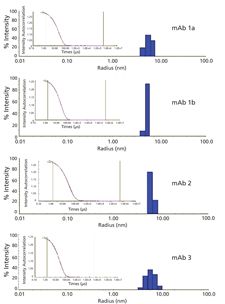
A 20-70 μL sample volume was used at a concentration of 1.0 mg/mL. Prior to sample analysis, the microtitre plate was centrifuged at 3000 rpm for 1 minute to remove air bubbles. Each sample was measured in triplicate, in which a single measurement consists of 10 acquisitions for 10 seconds at 25 °C. The raw data (auto-correlation functions) were analyzed by cumulants analysis and/or regularization analysis. The distribution plots were obtained from regularization analysis. The data were acquired at 25 °C using the temperature controlled
DynaPro Plate Reader II and DYNAMICS v7.1.9 software (Wyatt Technology Corporation). A 384-well plate was used to enable automated, high-throughput sample analysis.
Figure 1 shows the dispersion plots and histograms for mAb 1a and mAb 1b (IgG1) and mAb 2 and mAb 3 (IgG2). The results in Table I show that IgG1 and IgG2 have almost the same Rh while IgG2 has a greater degree of polydispersity than IgG1. This may be attributed to the two additional disulphide bonds present in IgG2, which often lead to greater heterogeneity.
CLICK FIGURE TO ENLARGE Figure 2: The autocorrelation functions and regularization histograms of antibody-drug conjugate (ADC) ADC1a, ADC1b (IgG1) vs. ADC3 and ADC4 (IgG2).
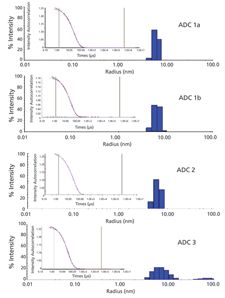
Figure 2 and Table II provide a comparison of corresponding IgG1 vs. IgG2 ADCs in the recommended lead formulations. A sample exhibiting %Pd < 20% is generally considered to be monodisperse. Therefore, a measured level of polydispersity beyond 20% indicates heterogeneity within the sample. The data suggest that although attachment of the small molecule drug to the mAb does not change Rh, the ADC samples become more polydisperse than the mAb samples. Hydrophobicity also increases slightly, indicating the presence of some high molecular-weight species.
Table II: The dynamic light scattering data of antibody-drug conjugates (ADCs): IgG1 (mAb1a-ADC and mAb1b-ADC) vs IgG2 (mAb2-ADC and mAb3-ADC). mAb is monoclonal antibody.
CLICK FIGURE TO ENLARGE Figure 3: Formulation screening: % polydispersity (Pd) of histidine formulations (a) vs. citrate formulations (b) and the histogram of the F5 formulation (c).
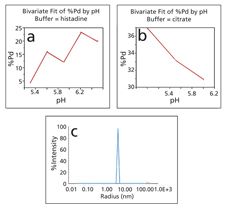
Formulation screening
Four mAb formulations that were stored at 2-8 °C were screened using automated DLS to determine their behavior under different conditions. Figures 3 and 4 show how %Pd and Rh of the proteins vary as pH is incrementally increased while temperature remains within the range of 2-8 °C. At pH 5.5, %Pd falls to 11.4 indicating that the sample is mostly monodisperse with less protein present in the higher molecular-weight region. Figure 4 also shows that Rh increases with pH. The shift can be attributed to increased electrostatic repulsion at higher pH. Additionally, a temperature trend study shows that at pH 5.5, the antibodies are relatively stable with a slight increase in Rh around 40 °C (data not shown).
CLICK FIGURE TO ENLARGE Figure 4: Dynamic light scattering histograms of Rh for four monoclonal antibody (mAb) formulations at different pH values.
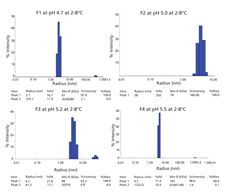
Finally, eight ADC formulations were analyzed in different histidine (F1-F5) and citrate (F6-F8) buffer solutions (see Table III). Figure 3 shows that proteins in three citrate formulations (F6-F8) are more polydispersed, with higher Rh than the histidine formulations. Overall, these data suggest that F5 at pH 5.3 with Rh of 6 nm and %Pd of 4.2% is the most stable formulation.
Table III: Dynamic light scattering data of eight ADC formulations in histidine (F1–F5) and citrate buffers (F6–F8). These data suggest that proteins in formulation F5 are the most stable. Pd is polydispersity, Rh is hydrodynamic radius.
Rapid and reliable ADC -characterization with HT-DLS
Routine optimization of formulations by DLS is made feasible by the speed and automation of in situ, plate-based DLS measurements using low-cost microtitre plates. HT-DLS is a rapid and useful biophysical method for characterizing and screening biotherapeutic formulations via extensive trend studies into pH, temperature, buffer, and excipient variations.
The analysis of hydrodynamic radius and polydispersity over a series of conditions enables drug product developers to closely monitor and control the stability of their formulation throughout every stage of the development process. The specific results in this study show that the attachment of small-molecule drugs to the mAb does not appreciably change the molecule’s average hydrodynamic size. Polydispersity, however, increases slightly, indicating the presence of some high-molecular-weight species in the form of small oligomers.
Article DetailsPharmaceutical Technology
Vol. 39, No. 10
Pages: 32–39
Citation: When referring to this article, please cite it as A La et al., “Characterization and Formulation Screening of mAb and ADCs by High-Throughput DLS,” Pharmaceutical Technology39 (10) 2015.
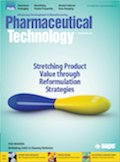
Drug Solutions Podcast: A Closer Look at mRNA in Oncology and Vaccines
April 30th 2024In this episode fo the Drug Solutions Podcast, etherna’s vice-president of Technology and Innovation, Stefaan De Koker, discusses the merits and challenges of using mRNA as the foundation for therapeutics in oncology as well as for vaccines.
Drug Solutions Podcast: Applying Appropriate Analytics to Drug Development
March 26th 2024In this episode of the Drug Solutions Podcast, Jan Bekker, Vice President of Business Development, Commercial and Technical Operations at BioCina, discusses the latest analytical tools and their applications in the drug development market.